Original Painting of a Pair of Koosa Clowns by Pablita Velarde - C3439D
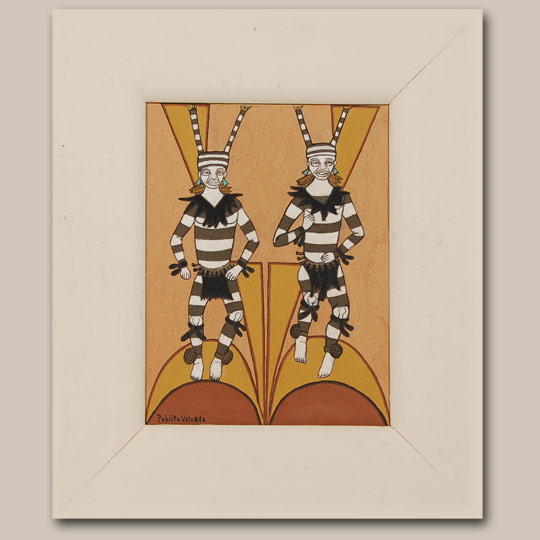 In the 1960s, when the Balcomb family operated an art gallery in Gallup, New Mexico, at 915 West Coal Avenue, Mrs. Balcomb, the family matriarch, signed a contract with Pablita Velarde (1918-2006) Tse Tsan - Golden Dawn for the Balcomb's to make silkscreen prints from four of Pablita's original mineral earth paintings. The four selected paintings were a single Koosa Clown figure, a single Mudhead Katsina figure, a pair of Koosa Clowns and a pair of Mudhead Katsinas.
In the 1960s, when the Balcomb family operated an art gallery in Gallup, New Mexico, at 915 West Coal Avenue, Mrs. Balcomb, the family matriarch, signed a contract with Pablita Velarde (1918-2006) Tse Tsan - Golden Dawn for the Balcomb's to make silkscreen prints from four of Pablita's original mineral earth paintings. The four selected paintings were a single Koosa Clown figure, a single Mudhead Katsina figure, a pair of Koosa Clowns and a pair of Mudhead Katsinas.
Individual Navajo Sterling Silver Concha - Concho with Leather Backing - 25865
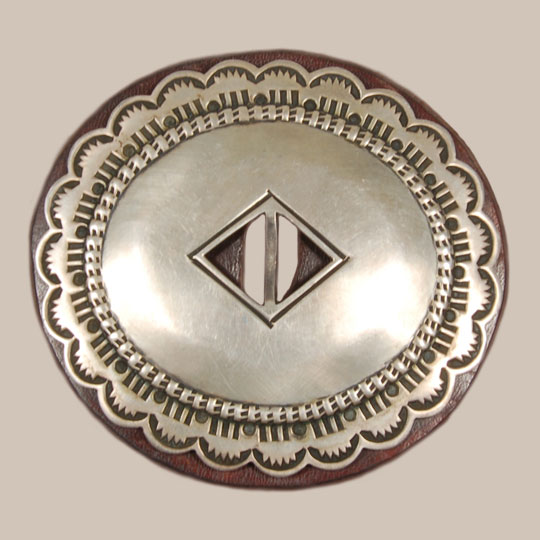 Concha belts with several silver conchas are often made smaller to fit a person by removing one or more of the conchas. That is the story of this single concha. It was removed from a concha belt and put in a drawer for safekeeping and has recently been discovered.
Concha belts with several silver conchas are often made smaller to fit a person by removing one or more of the conchas. That is the story of this single concha. It was removed from a concha belt and put in a drawer for safekeeping and has recently been discovered.
It is a beautiful oval sterling concha in the first phase style with leather backing. There is stamping near the outer edge and the edge is scalloped. This concha could easily be converted to a handsome belt buckle.
Zuni Pueblo Miniature Turquoise Bear Fetish Pendant - C3773P
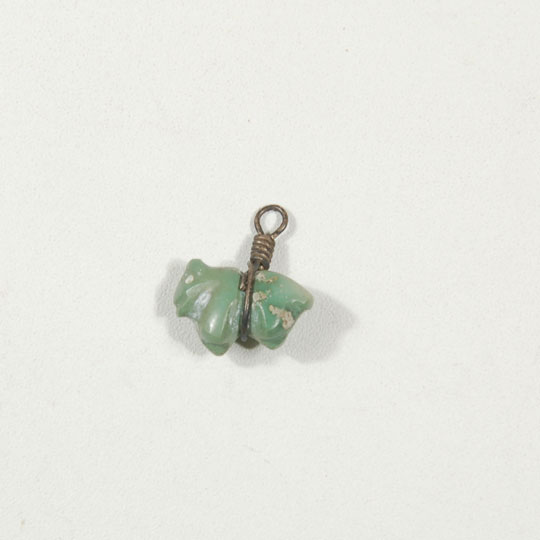 This beautiful green turquoise miniature bear fetish has been wrapped in wire to facilitate use as a pendant. The formation of such a small fetish is amazing. The carving was executed with great care.
This beautiful green turquoise miniature bear fetish has been wrapped in wire to facilitate use as a pendant. The formation of such a small fetish is amazing. The carving was executed with great care.
The fetish has been stored for years in a small container with yellow corn pollen. That is a traditional manner in which they are stored and ceremonially fed by Zuni persons. Corn Pollen and Cornmeal can be a blessing for protection, understanding and forgiveness. White corn is thought, by the Navajo, to be male, yellow corn is female and could have a similar meaning for the Pueblo people, but that has not been confirmed by us.
Navajo Tufa Cast Sterling Silver and Turquoise Letter Opener - 25867
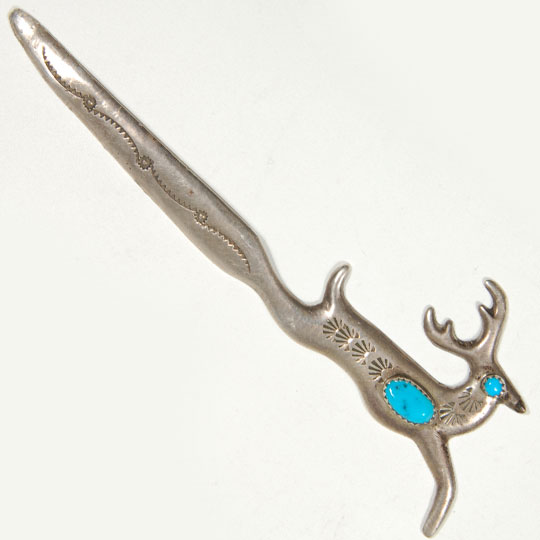 Navajo silversmiths crafted jewelry and other silver objects to appeal to the tastes of the traveling adventurer. A popular non-jewelry item was the letter opener.
Navajo silversmiths crafted jewelry and other silver objects to appeal to the tastes of the traveling adventurer. A popular non-jewelry item was the letter opener.
There are various methods of producing silver objects. One method is sand casting or, more properly, tufa casting. A mold was made out of tufa and molten silver was then poured into the mold. After the silver cooled, the piece was taken out and polished. Finally, finishing touches, such as the addition of stones and stamp work, were added.
Navajo Silver and Turquoise Dangle Earrings - C3670E
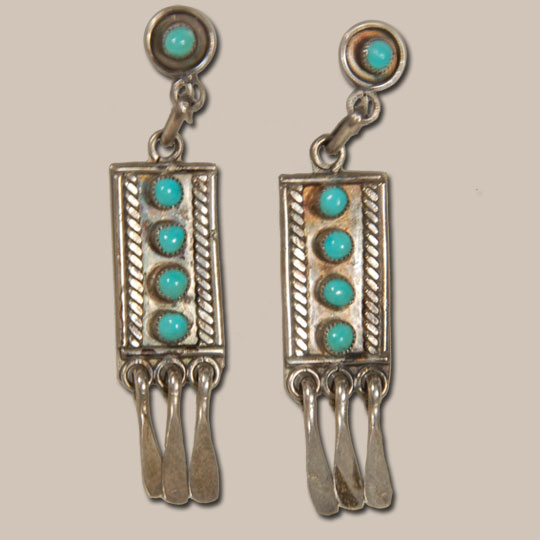 This pair of Navajo-made silver and turquoise earrings is fitted with clips but could easily be converted for pierced ears if desired. The main item of the earrings is the rectangular silver sheet with four domed turquoise cabs set along its center line. Three silver dangles drop from the base. The clip portion of the set has a single stone set as the center piece of the round silver disc.
This pair of Navajo-made silver and turquoise earrings is fitted with clips but could easily be converted for pierced ears if desired. The main item of the earrings is the rectangular silver sheet with four domed turquoise cabs set along its center line. Three silver dangles drop from the base. The clip portion of the set has a single stone set as the center piece of the round silver disc.
Silver and Turquoise Navajo Single Turquoise Stone Ring - C3670D
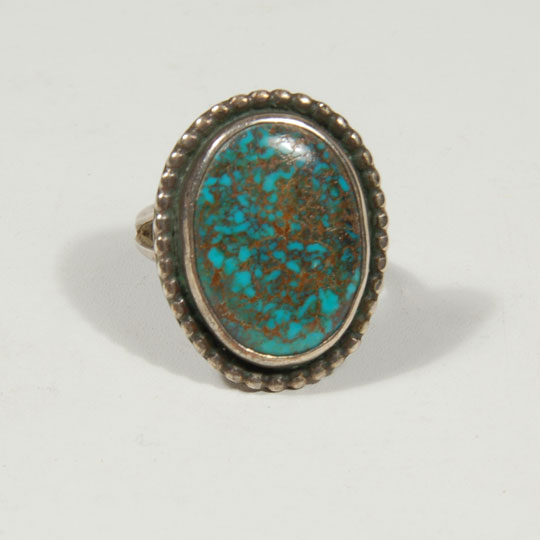 Rather than classify this as a silver and turquoise ring, perhaps it is more appropriate to classify it as a turquoise ring mounted on silver because the turquoise cab is the predominant item of view. The stone is magnificent-an equal amount of copper matrix and turquoise. The stone is oval and domed and set in a plain silver bezel mounted on a silver disc with silver dots around the perimeter. The shank is split into two branches as it approaches the top of the ring.
Rather than classify this as a silver and turquoise ring, perhaps it is more appropriate to classify it as a turquoise ring mounted on silver because the turquoise cab is the predominant item of view. The stone is magnificent-an equal amount of copper matrix and turquoise. The stone is oval and domed and set in a plain silver bezel mounted on a silver disc with silver dots around the perimeter. The shank is split into two branches as it approaches the top of the ring.
Navajo Silver and Turquoise Navajo Cluster Ring - C3670C
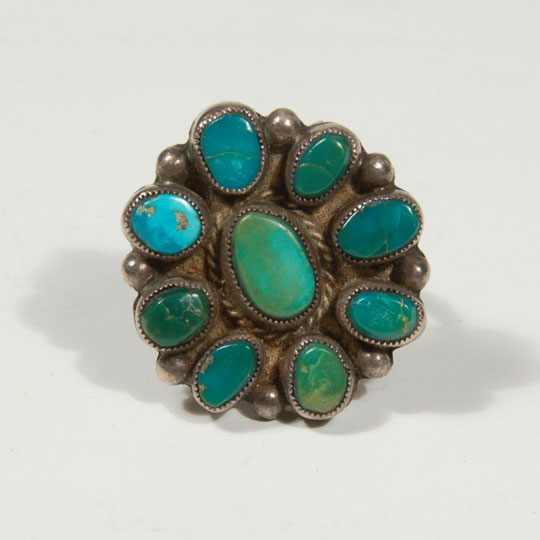 Navajo jewelers were skilled in using elegant silver settings to highlight the beauty of turquoise stones. This cluster ring has eight high grade turquoise stones surrounding a larger middle stone. The depth and color of the stones are the focal points of the ring. The unknown Navajo artist has set these stones in perfectly crafted saw-tooth bezels with a tiny silver drop between each stone. Between the center stone and the surrounding stones is a fine twisted silver wire. The uniqueness of each individual stone shines through as a result of the well-designed silver setting. The Southwest Indian Jewelry ring is probably from the 1940s era.
Navajo jewelers were skilled in using elegant silver settings to highlight the beauty of turquoise stones. This cluster ring has eight high grade turquoise stones surrounding a larger middle stone. The depth and color of the stones are the focal points of the ring. The unknown Navajo artist has set these stones in perfectly crafted saw-tooth bezels with a tiny silver drop between each stone. Between the center stone and the surrounding stones is a fine twisted silver wire. The uniqueness of each individual stone shines through as a result of the well-designed silver setting. The Southwest Indian Jewelry ring is probably from the 1940s era.
An Amazing Squash Blossom Necklace from Zuni Pueblo - C3670A
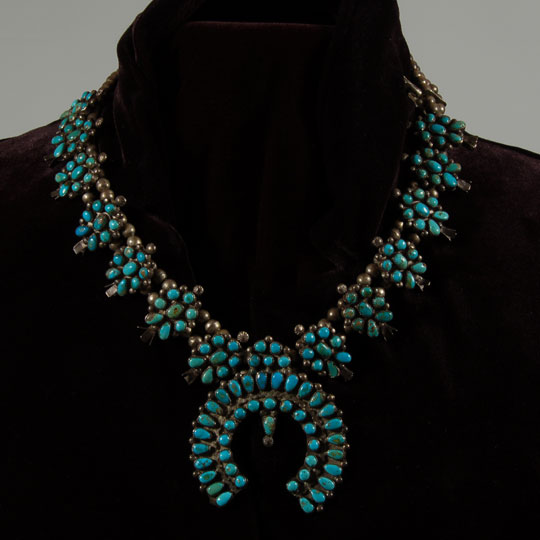 Sometime in the history of Native American jewelry from the Southwest, someone named a necklace, such as this one, a "squash blossom" necklace. Technically, the blossoms attached to the necklace were derived from the pomegranate. The area with the small turquoise cabs that looks like a blossom and the silver protrusions were copied from the silver pomegranate blossoms seen on the trousers of the vaquero from Spain and Mexico. Regardless of the name, these have been among the most popular Native necklaces for decades, certainly as early as pre-World War II.
Sometime in the history of Native American jewelry from the Southwest, someone named a necklace, such as this one, a "squash blossom" necklace. Technically, the blossoms attached to the necklace were derived from the pomegranate. The area with the small turquoise cabs that looks like a blossom and the silver protrusions were copied from the silver pomegranate blossoms seen on the trousers of the vaquero from Spain and Mexico. Regardless of the name, these have been among the most popular Native necklaces for decades, certainly as early as pre-World War II.
Black-on-black Low Open Jar signed Marie & Julian by Maria Martinez - C3661A
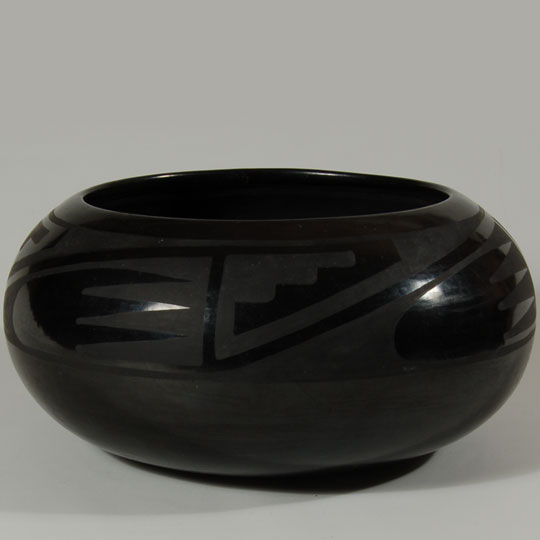 Maria Poveka Martinez (1887-1980) and Julian Martinez (1885-1943) worked together producing pottery from the early 1900s-she making the beautiful Tewa shape vessels and he painting beautiful designs in traditional Polychrome style. Because Maria was considered the best potter at San Ildefosno, she was selected to experiment on reproducing the prehistoric wares being excavated. She and Julian worked diligently for several years to recreate the earlier pottery and Julian painted designs in the traditional Polychrome style. It was not until around 1912, that they became interested in experimenting with the blackware of previous periods. It was another 10 years before they achieved satisfactory results.
Maria Poveka Martinez (1887-1980) and Julian Martinez (1885-1943) worked together producing pottery from the early 1900s-she making the beautiful Tewa shape vessels and he painting beautiful designs in traditional Polychrome style. Because Maria was considered the best potter at San Ildefosno, she was selected to experiment on reproducing the prehistoric wares being excavated. She and Julian worked diligently for several years to recreate the earlier pottery and Julian painted designs in the traditional Polychrome style. It was not until around 1912, that they became interested in experimenting with the blackware of previous periods. It was another 10 years before they achieved satisfactory results.
Hopi Burnished Clay Seed Jar with Ear of Corn by Iris Youvella Nampeyo - C3658E
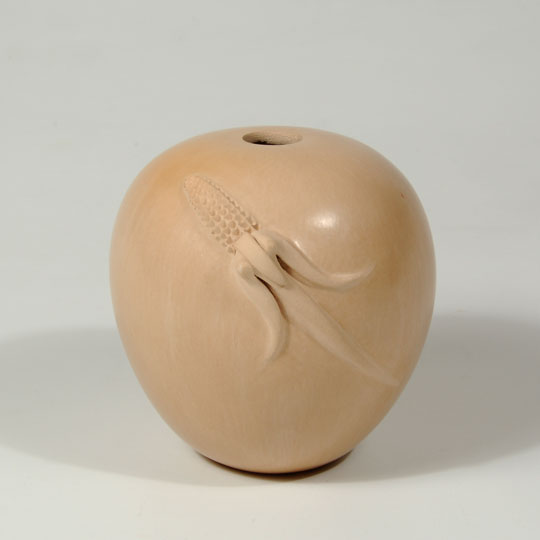 Iris Youvella Nampeyo is a daughter of Fannie Nampeyo and granddaughter of Nampeyo of Hano, who is known for her sculptural design pottery that she has mastered to the finest detail. This style of sculpture was first made by Elizabeth White - Polingaysi and further refined by her nephew, Al Colton - Qöyawayma.
Iris Youvella Nampeyo is a daughter of Fannie Nampeyo and granddaughter of Nampeyo of Hano, who is known for her sculptural design pottery that she has mastered to the finest detail. This style of sculpture was first made by Elizabeth White - Polingaysi and further refined by her nephew, Al Colton - Qöyawayma.
A Pair of Pueblo Animal Dancers by Joseph Tapia - C3667B
 There are two individual paintings of pueblo animal dancers which have been framed together in a single frame. One is a Deer Dancer and the other a Ram Dancer. Both are similar in style and size and both by Joseph Tapia, a painter from Tesuque Pueblo who passed away in 1991 at the young age of 32 years. The paintings have been framed so that the two dancers face each other.
There are two individual paintings of pueblo animal dancers which have been framed together in a single frame. One is a Deer Dancer and the other a Ram Dancer. Both are similar in style and size and both by Joseph Tapia, a painter from Tesuque Pueblo who passed away in 1991 at the young age of 32 years. The paintings have been framed so that the two dancers face each other.
“Lady in the Corn Field” signed Tsa-sah-wee-eh by Helen Hardin - C3667A
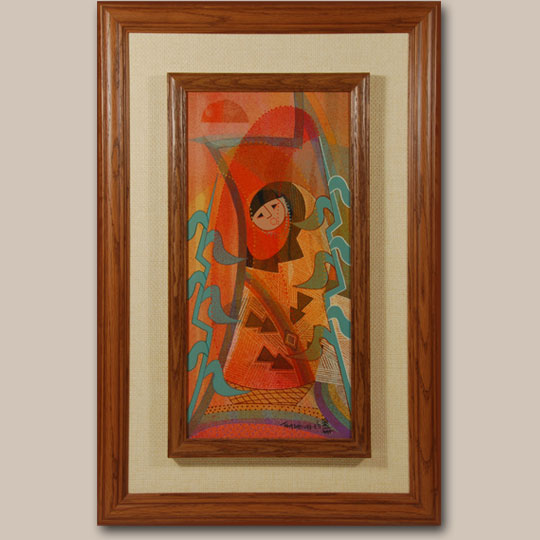 It has been observed that when Helen Hardin was involved in a painting, she was totally involved until that painting was completed. Her life was dedicated to her work as she retreated into the spirituality of what she was doing. Born of a Santa Clara Pueblo woman, Pablita Velarde, and a non-Indian man, raised in Albuquerque away from pueblo events, she nevertheless drew on her Native culture. She had no patience to follow the two-dimensional painting style of the Santa Fe Indian Schoolto which so many other artists were following.
It has been observed that when Helen Hardin was involved in a painting, she was totally involved until that painting was completed. Her life was dedicated to her work as she retreated into the spirituality of what she was doing. Born of a Santa Clara Pueblo woman, Pablita Velarde, and a non-Indian man, raised in Albuquerque away from pueblo events, she nevertheless drew on her Native culture. She had no patience to follow the two-dimensional painting style of the Santa Fe Indian Schoolto which so many other artists were following.
Navajo Painting of a Deer and Fawn by Quincy Tahoma - C3652
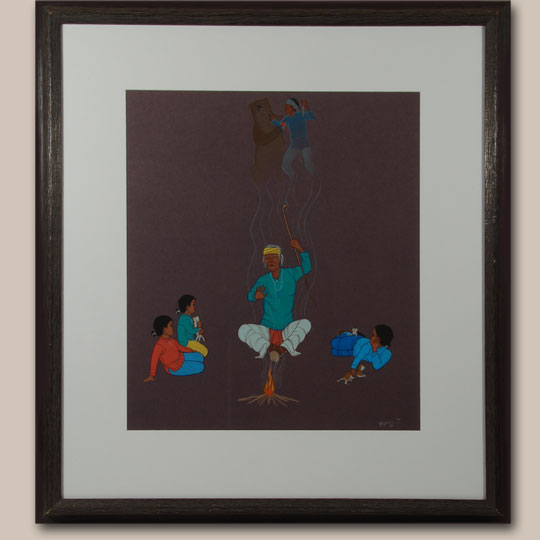 Realistic paintings of animals reflect much of his early life. No matter how violent his portrayals became in later years, Quincy Tahoma (1917-1956) Water Edge still painted animals with affection and great beauty. This pair of running deer is typical of his treatment of animals. They are romping around enjoying the snow.
Realistic paintings of animals reflect much of his early life. No matter how violent his portrayals became in later years, Quincy Tahoma (1917-1956) Water Edge still painted animals with affection and great beauty. This pair of running deer is typical of his treatment of animals. They are romping around enjoying the snow.
This painting was completed in 1942 when Tahoma was 25 years of age. He had attended the Santa Fe Indian School for four years, from 1936-1940, entering in the seventh grade. He was a student at the same time as Harrison Begay, Pablita Velarde, Geronima Montoya, Andy Tsihnahjinnie, and Gerald Nailor, and studied under the tutelage of Dorothy Dunn at The Studio.
Grandfather Storyteller and his Enthralled Kid Audience by Beatien Yazz - C3665C
 We are all familiar with the famous U. S. Marine battalion known as the "Code Talkers" and the reasons that they were so successful in communicating by code during World War II without the Japanese being able to break their code. They used Navajo words as substitutes for English words. As an example, the Navajo word for "turtle" was used for the military vehicle word "tank." Those Navajo young men, of whom Beatien Yazz was one, have been praised for their contribution to shortening the war in the Pacific. The reason this worked was that the Navajo language was only a spoken language at that time. Since, it has been given an alphabet and lexicon.
We are all familiar with the famous U. S. Marine battalion known as the "Code Talkers" and the reasons that they were so successful in communicating by code during World War II without the Japanese being able to break their code. They used Navajo words as substitutes for English words. As an example, the Navajo word for "turtle" was used for the military vehicle word "tank." Those Navajo young men, of whom Beatien Yazz was one, have been praised for their contribution to shortening the war in the Pacific. The reason this worked was that the Navajo language was only a spoken language at that time. Since, it has been given an alphabet and lexicon.
Navajo Painting “The Flute Player” by David Chethlahe Paladin - C3791A
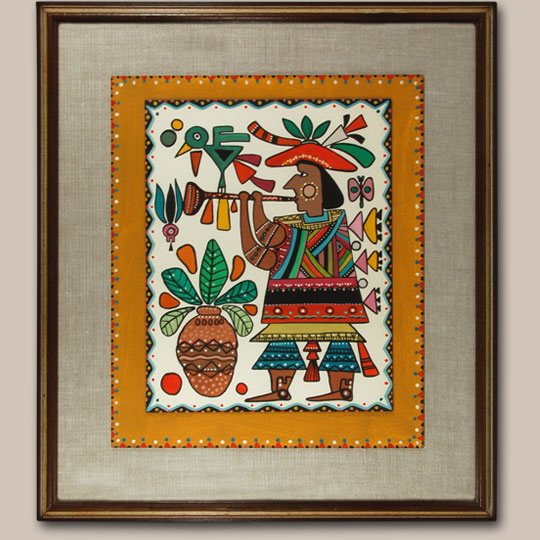 David Chethlahe Paladin was a student of the Santa Fe Indian School, where he learned the basic fundamentals of painting from Dorothy Dunn. Dunn encouraged her students to document and celebrate their cultures. As a young man, Paladin struggled with his identity as the mixed-race son of a Navajo woman and a visiting white missionary. As he developed as an artist, he began to display a genuine affection for his Navajo culture. His style evolved considerably over the years, and ultimately drew from a wide variety of influences while always remaining grounded in his Native American roots. Paladin was trained as a shaman, serving the Huichol and Tarahumara tribes in Mexico as well as his native Navajo people.
David Chethlahe Paladin was a student of the Santa Fe Indian School, where he learned the basic fundamentals of painting from Dorothy Dunn. Dunn encouraged her students to document and celebrate their cultures. As a young man, Paladin struggled with his identity as the mixed-race son of a Navajo woman and a visiting white missionary. As he developed as an artist, he began to display a genuine affection for his Navajo culture. His style evolved considerably over the years, and ultimately drew from a wide variety of influences while always remaining grounded in his Native American roots. Paladin was trained as a shaman, serving the Huichol and Tarahumara tribes in Mexico as well as his native Navajo people.
Untitled Painting of a Religious Procession by David Chethlahe Paladin - C3791B
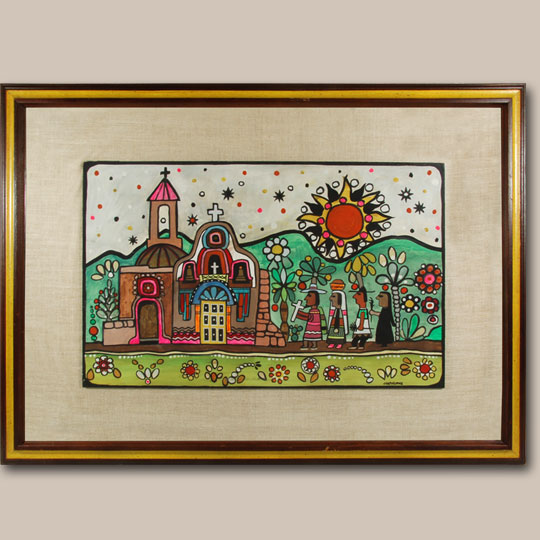 David Chethlahe Paladin's work evolved drastically over the course of his career, moving away from what was common among Native American artists of his time towards more abstract contemporary work. Though his methods changed over time, his themes remained the same: spirituality, creation, and rebirth. Paladin depicted the same rituals, ceremonies and symbols as many of his Navajo contemporaries, but did so with a uniquely creative perspective. He celebrated life, above all else, and this painting is a fine example of his singular style.
David Chethlahe Paladin's work evolved drastically over the course of his career, moving away from what was common among Native American artists of his time towards more abstract contemporary work. Though his methods changed over time, his themes remained the same: spirituality, creation, and rebirth. Paladin depicted the same rituals, ceremonies and symbols as many of his Navajo contemporaries, but did so with a uniquely creative perspective. He celebrated life, above all else, and this painting is a fine example of his singular style.
Original Navajo Painting of a Quail by Gerald Nailor - C3788C
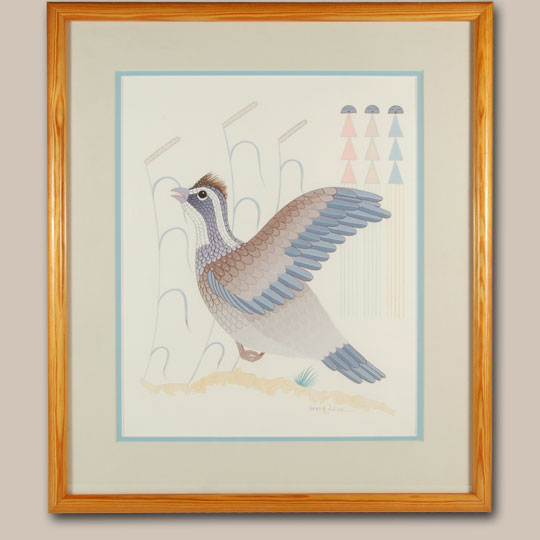 In 1951, an arts silkscreen printing business named Tewa Enterprises was started in Santa Fe by Charles Barrows, a silkscreen printer, and Harrison Begay, the well-known Navajo painter. Tewa's mission was to hand silkscreen reproductions of Navajo and Pueblo paintings and make them available to a wide audience at low prices. Subsequently, the current owner, Cathie Sullivan purchased Tewa Enterprises and now the business has ceased work.
In 1951, an arts silkscreen printing business named Tewa Enterprises was started in Santa Fe by Charles Barrows, a silkscreen printer, and Harrison Begay, the well-known Navajo painter. Tewa's mission was to hand silkscreen reproductions of Navajo and Pueblo paintings and make them available to a wide audience at low prices. Subsequently, the current owner, Cathie Sullivan purchased Tewa Enterprises and now the business has ceased work.
Navajo Sterling Silver Sandcast Belt Buckle - 25864
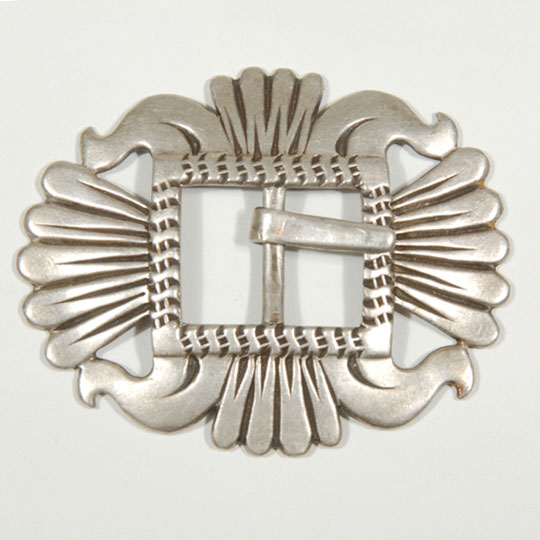 Tufa casting, often erroneously referred to as sand casting, is one of the earliest techniques used by the Navajo smiths. Today, it is still accomplished in the same manner as it was 150 years ago. Casting techniques among the Navajo developed about 1875. Volcanic tuff, or tufa, which is widely available on the Navajo Reservation, is used to create molds for casting. The artisan carves the desired design into a block of tufa, and cuts a matching piece of tufa to correspond to the carved one. Molten silver is then poured into the mold, created by putting the two pieces of tufa together, to fill the carved areas. The result is an item of jewelry that could now be refined and worked to make the desired piece.
Tufa casting, often erroneously referred to as sand casting, is one of the earliest techniques used by the Navajo smiths. Today, it is still accomplished in the same manner as it was 150 years ago. Casting techniques among the Navajo developed about 1875. Volcanic tuff, or tufa, which is widely available on the Navajo Reservation, is used to create molds for casting. The artisan carves the desired design into a block of tufa, and cuts a matching piece of tufa to correspond to the carved one. Molten silver is then poured into the mold, created by putting the two pieces of tufa together, to fill the carved areas. The result is an item of jewelry that could now be refined and worked to make the desired piece.
Navajo Silver and Drilled Turquoise Ring - C3789C
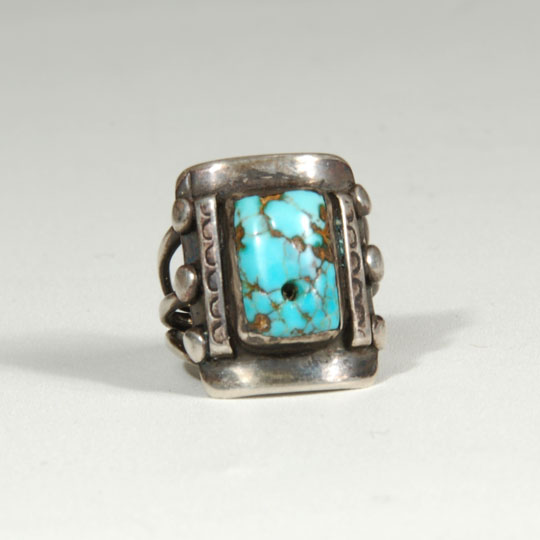 The base of this Navajo ring is a combination of three silver wires soldered together at the mid-point and individually soldered to a curved silver backing. Mounted on the backing is a beautiful sky blue turquoise cab that is drilled with a hole, which may indicate it was once a tab earring. The silver backing has the effect of a shield which visually elevates the turquoise stone to more prominence. The stone is a beautiful blue with an excellent array of copper-colored matrix.
The base of this Navajo ring is a combination of three silver wires soldered together at the mid-point and individually soldered to a curved silver backing. Mounted on the backing is a beautiful sky blue turquoise cab that is drilled with a hole, which may indicate it was once a tab earring. The silver backing has the effect of a shield which visually elevates the turquoise stone to more prominence. The stone is a beautiful blue with an excellent array of copper-colored matrix.
Navajo Sterling Silver Bracelet with Oval Turquoise Stone - C3789D
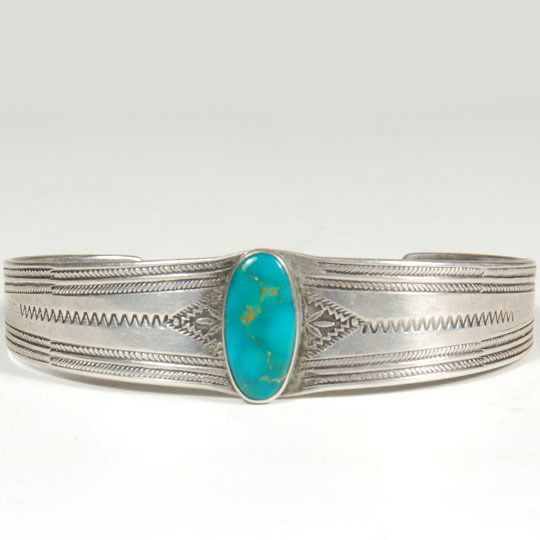 Elegant, dainty, lace-like could be descriptions of this bracelet. It is one of the most finely detailed works imaginable. It appears that channels were cut into the silver base and then strips of silver rope were inserted into the channels. The other option to consider is that it is silver overlay where a thin sheet of silver serves as the backing and then a second layer of silver with cut-out designs is overlaid on the backing. Regardless of the technique used, it is a beautiful bracelet with a deep blue/green turquoise stone at the center.
Elegant, dainty, lace-like could be descriptions of this bracelet. It is one of the most finely detailed works imaginable. It appears that channels were cut into the silver base and then strips of silver rope were inserted into the channels. The other option to consider is that it is silver overlay where a thin sheet of silver serves as the backing and then a second layer of silver with cut-out designs is overlaid on the backing. Regardless of the technique used, it is a beautiful bracelet with a deep blue/green turquoise stone at the center.

